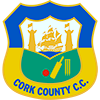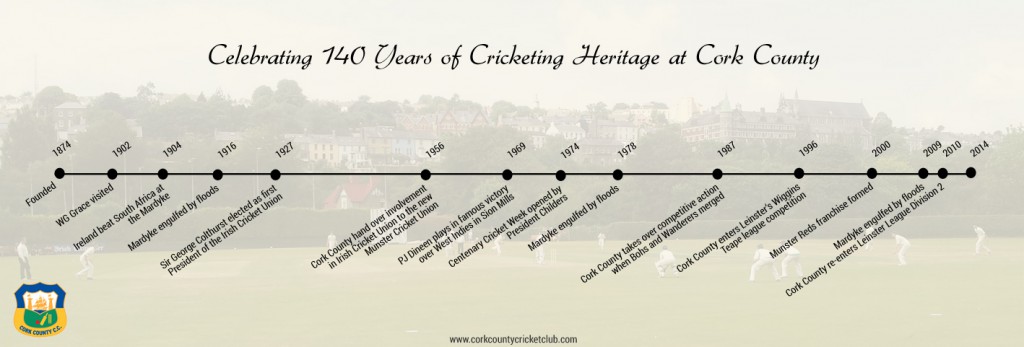The year is 1874; in France impressionism is first born, in America the Texas-Indian wars continue to rage, while elsewhere Ernest Shackleton, Robert Frost and Harry Houdini are born.
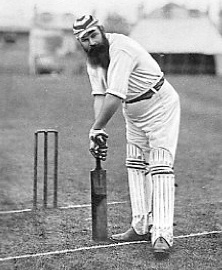 In Cork a similar birth is underway, but this is of a sporting variety. On November 25th 1873, over 140 years ago, ten years before the foundation of the GAA and over a century before the establishment of Cork City FC, a Cork legend himself Mr. W.H Sharman Crawford sent a letter to a list of those interested, calling on the creation of a cricket club which would encompass both city and county. Previous to that, Cork Cricket Club, established in 1849, had been providing the game to those in the city, but a huge number from outside Munster’s capital were unable to pick up a bat and ball competitively. The letter informed those that Crawford, along with two associates Anderson Cooper and Thomas Hewitt, were to ‘form a new Cricket club, which would be a credit to both the County and the City’. Life (a once off payment of £10), playing (£2 yearly) and non-playing (£1 yearly) memberships were available, with the funds dedicated to the building of a new pavilion, leasing the Mardyke grounds, and the payment of a professional bowler.
In Cork a similar birth is underway, but this is of a sporting variety. On November 25th 1873, over 140 years ago, ten years before the foundation of the GAA and over a century before the establishment of Cork City FC, a Cork legend himself Mr. W.H Sharman Crawford sent a letter to a list of those interested, calling on the creation of a cricket club which would encompass both city and county. Previous to that, Cork Cricket Club, established in 1849, had been providing the game to those in the city, but a huge number from outside Munster’s capital were unable to pick up a bat and ball competitively. The letter informed those that Crawford, along with two associates Anderson Cooper and Thomas Hewitt, were to ‘form a new Cricket club, which would be a credit to both the County and the City’. Life (a once off payment of £10), playing (£2 yearly) and non-playing (£1 yearly) memberships were available, with the funds dedicated to the building of a new pavilion, leasing the Mardyke grounds, and the payment of a professional bowler.
The Earl of Cork, the Earl of Bandon, Crawford himself and Richard Beamish were amongst those on the list of initial life members, and its president George Colthurst was the first of a long line of Presidents from the Colthurst family (With each subsequent president until 1954 a member of said clan), who formed the backbone of the original club along with the Beamish family.
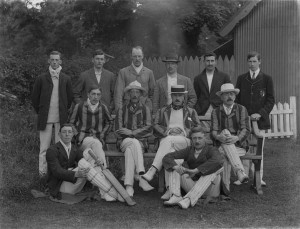 The game was flourishing pre-war, with clubs all over the county and province, however it was Cork County who were the big name in the South, and regularly hosted teams from Dublin such as Trinity (Ireland’s oldest club, with earliest references dated 1835), Phoenix, Leinster and Clontarf. In 1909 a senior cricket league was established so that the local sides around Munster could pit their wits against each other. Its popularity and participation was the equivalent to that of football in the modern day, and townland teams from Mallow to Bandon, Buttevant to Midleton could face off against each other, even as far as Limerick! A year later Cork County CC became affiliated with the Irish Cricket Union, and thus, with no other members in the South, governed cricket in Munster, forty-seven years before the establishment of the Munster Cricket Union.
The game was flourishing pre-war, with clubs all over the county and province, however it was Cork County who were the big name in the South, and regularly hosted teams from Dublin such as Trinity (Ireland’s oldest club, with earliest references dated 1835), Phoenix, Leinster and Clontarf. In 1909 a senior cricket league was established so that the local sides around Munster could pit their wits against each other. Its popularity and participation was the equivalent to that of football in the modern day, and townland teams from Mallow to Bandon, Buttevant to Midleton could face off against each other, even as far as Limerick! A year later Cork County CC became affiliated with the Irish Cricket Union, and thus, with no other members in the South, governed cricket in Munster, forty-seven years before the establishment of the Munster Cricket Union.
The first World War from 1914 to 1918 saw the club struggle, but an article by Cyril O’Donnell in Cork County’s Centenary Book pays homage to then secretary Raymond Savage for securing the club’s future into the inter-war years. Post-war saw a number of touring sides visit Cork including the English Counties XI, who were defeated at the Mardyke by the home side! Well-known sides like Oxford Authentics, Cambridge Peterhouse, The Royal Engineers and Australian Old Collegians visited Cork to play at what remains one of the most scenic cricket pitches in Ireland, or indeed the United Kingdom.
The banning of foreign sports by the GAA in 1901 did little to help the game, and as the GAA rose to prominence on the wave of a republican revolution during the 1910s and 1920s, so too did the garrison game of cricket suffer. However, its subsequent release and the increased availability of cricket to all has now meant many members of County’s teams from first to third are dual-stars in their own right, playing both GAA and cricket all-year ‘round.
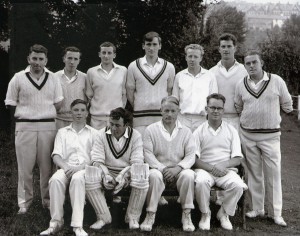 The club’s most difficult days came during the Second World War, in which cricket was limited to local leagues and junior cricket. With times so tough County were restricted to playing within Cork, while the annual interprovincial between Munster and Leinster was the only game involving a side from outside the Rebel County.
The club’s most difficult days came during the Second World War, in which cricket was limited to local leagues and junior cricket. With times so tough County were restricted to playing within Cork, while the annual interprovincial between Munster and Leinster was the only game involving a side from outside the Rebel County.
In 1970 the club bought the Mardyke grounds for £20,000 and a complete re-development was undertaken to make the ground one of the best in the country, while a year later two squash courts were added, and still prove hugely popular given their convenient location. In 1974 the club celebrated its centenary year, with the celebratory week opened by than Irish President Erskine Childers.
The 70s and 80s saw top sides from across the water play in the Mardyke, with club memberships, and in particular junior memberships continually rising on the back of the foreign games ban lifting in 1971. This allowed people young and old who were previously unable sample the different sports now available to them, and the game down the ‘Dyke flourished.
In 2001, the decision was made to form a cricket franchise from Munster, which would compete in the Leinster Leagues. The Munster Reds competed in the top Leinster league for a time but when they disbanded in 2008 the door was opened for Cork County to take their place, and thus establish themselves as one of the best clubs in Ireland.
This year the club is on course for back-to-back promotions, which would see them playing in the top division in Leinster, not as a conglomerate franchise, but under the one name, Cork County. On Tuesday August 20th they face a President’s selection to mark their 140 year history, and will always be a historic part of the Cork sporting fabric.
The Mardyke Cricket Grounds
Undoubtedly one of the most scenic grounds in the country, cricket has been played at the Mardyke since 1850, with the predecessor to Cork County, Cork Cricket Club providing top-class cricket for the citizens of Cork City
In total eleven games involving the senior Irish team have been played down the ‘Dyke, fittingly it was cricket’s best-known personality W.G Grace who took the field first to bat at a Cork international match. The game, a challenge match between Ireland and London County in 1903, was Ireland’s only game that year, and was taken with the utmost of seriousness with trials held in the weeks previous.
Grace, then 54, got out for one in the first innings, and followed that up with a relatively poor 24 as the two sides played out an entertaining draw. Excusing his failings the great man proclaimed “How could anyone be expected to play cricket in such beautiful surroundings”, an alibi that’s hard to contest!
The following year the Irish defeated a strong South African side who would go on to beat England in Lords on the same tour and secure test status three years later. The 30th May 1947 saw the inaugural first-class game to be played down the ‘Dyke, with Ireland hosting Scotland in a tie which was unfortunately washed out on the second day and ended a draw
A draw was again the outcome fourteen years later, this time in a three day game which is remembered as one of the most tedious in Irish cricketing history. It took 70 overs for Scotland to make 166 all out and the Irish chase wasn’t much faster, a draw was obvious from the end of the first day, in a game which failed to ignite the public’s imagination.
Nine years later Denmark were the visitors in a match which saw Pat Dineen became the first Corkman to play for Ireland in Cork since 1930, despite Ireland’s hard work the visitors were always going to settle for a draw after a washed out first day. A year later Ireland secured their biggest win since 1936 with a 260 run victory over Wales in the first of a continuing series.
Cork County themselves have hosted some of the biggest names in cricket at the Mardyke. Players like Nick Knight, Nasser Hussain and Graham Gooch have all graced the middle at the ‘Dyke, and experienced the beautiful surroundings Grace once raved about.
Cork County’s Internationals
Despite the perception that Munster cricket is far inferior to that in Leinster and up North, Cork County Cricket club has still contributed thirty-two players to the Irish senior international team, whether playing with the club at the time, or progressing from the fields of the Mardyke; and countless others to underage teams over the past 140 years.
Sir Tim Carew O’Brien is one of the first, and most successful to be associated with Cork County. Sir O’Brien actually played for England in two test matches in the 1880s during a hugely successful first-class career of 266 games, and was capped a further seven times by Ireland in 1907, scoring an Irish record against England of 167, a record which remained until 1973.
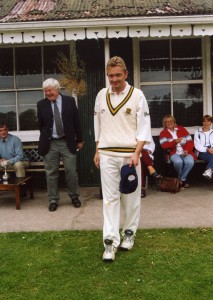 The first man from County to represent the Emerald Isle was Sir George St. John Colthurst, capped twice in 1879, and who would later go on to be President of the club from 1878-1926 before his son Sir George Oliver Colthurst took the reigns from 1926-1954, while Pascoe William Grenfell Stuart played for his country five times between 1892 and 1904, a Cork County regular Stuart actually captained Munster during an interprovincial in 1931 at the tender age of 62!
The first man from County to represent the Emerald Isle was Sir George St. John Colthurst, capped twice in 1879, and who would later go on to be President of the club from 1878-1926 before his son Sir George Oliver Colthurst took the reigns from 1926-1954, while Pascoe William Grenfell Stuart played for his country five times between 1892 and 1904, a Cork County regular Stuart actually captained Munster during an interprovincial in 1931 at the tender age of 62!
Pat Dineen is the most capped Cork County player, with 23. Dineen, who subsequently chaired the likes of Bord Gais, Irish Steel and Bord na Mona, was a member of the Irish side which infamously bowled out the West Indies for 25 at Sion Mills on July 2nd 1969, securing what was and continues to be one of the all time sporting upsets.
The most famous Irish international in Cork circles is the sporting icon Noel Cantwell. Known more for his footballing ability (A lengthy career with two of England’s most successful clubs Manchester United and West Ham, plus 36 Irish caps), the Presentation College graduate was also a dab hand with the bat and ball. A left-hand bat and right arm medium bowler, Cantwell played five times for Ireland, before football began to take over.
One of Cork County’s finest and most respected all-rounders of the modern era, John Power, earned a deserved international call up in a 3-day match against the MCC in 1994 (scorecard) and was unlucky not to have added to that cap throughout the remainder of his career. County’s last international Ted Williamson’s cap came in 1999 for a game against the MCC, while he has also played for the Marylebone Cricket Club against Ireland ‘A’ at Lords. He has since played a part in coaching the likes of Irish underage internationals Ruadhan Jones and Rory O’Keeffe from an early age, showing that Munster cricket still has an awful lot to contribute to the international set up.
The current Cork County side… a continuation of the legacy
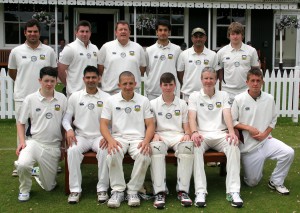 While Cork County is inevitably steeped in history, the current side are living up to their predecessors. Led by Club’s Captain, Ross Durity, and overseas professional and former Gauteng batsman Stephan Groblar, County have been boosted in the last few years, picking up young talents like Anthony O’Reilly and the big-hitting Morne Bauer from Cork Harlequins.
While Cork County is inevitably steeped in history, the current side are living up to their predecessors. Led by Club’s Captain, Ross Durity, and overseas professional and former Gauteng batsman Stephan Groblar, County have been boosted in the last few years, picking up young talents like Anthony O’Reilly and the big-hitting Morne Bauer from Cork Harlequins.
Following the collapse of the Munster Reds franchise in 2008, the door was opened for County to enter as a separate club. After winning the Division 3 last year, Cork County are now eyeing up successive promotions, this time to the top Leinster Division, which would be quite a significant achievement for both Cork County and cricket in Munster.
2013 was a bumper year for the firsts, winning the Munster Senior Cup and League on top of the Division three win. This year looks set to be the same, with only four games left of the season remaining the Mardyke side have only lost one game, with a key showdown against first-placed Malahide on Sunday August 17th.
It would appear the Club is in safe hands with the likes of Chris Banon, Tim Clifford, Ian Coleman, Chris van Heerden, Aidan Kelleher and his younger brother Brian progressing through the ranks.
Kevin Galvin (courtesy of the Evening Echo)